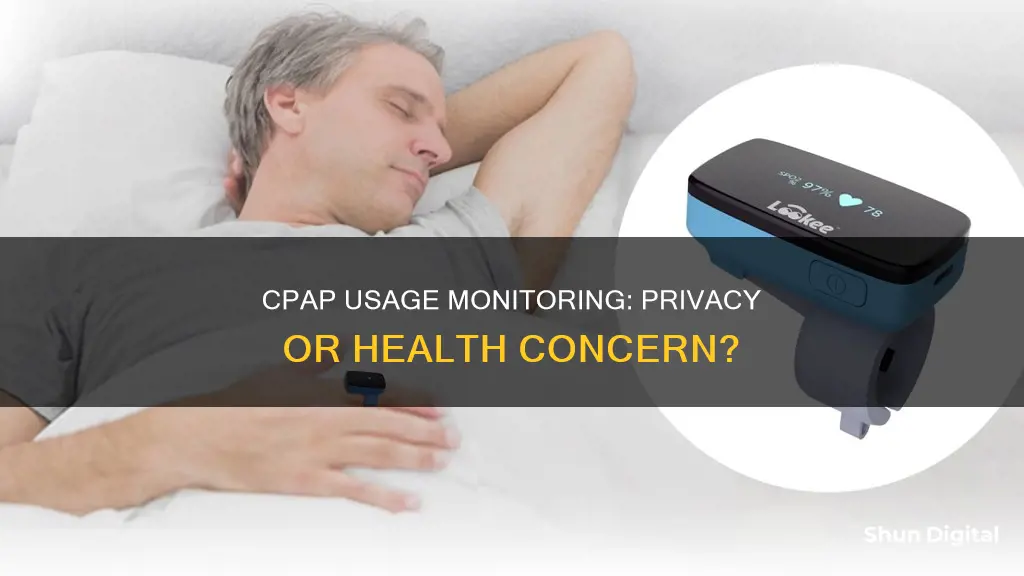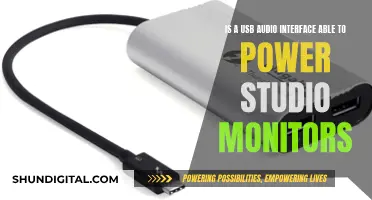
CPAP usage is monitored to ensure patients are receiving effective treatment for sleep apnea. Compliance is measured by tracking the number of times and the total hours a patient uses their CPAP machine, with the data stored on the device and accessible via SD card, automatic cloud upload, or a built-in display. This information helps doctors assess treatment effectiveness and insurance companies determine coverage. While privacy concerns exist, monitoring CPAP usage helps improve patient outcomes and enables remote adjustments to pressure settings and mask fittings.
| Characteristics | Values |
|---|---|
| Purpose of monitoring | To ensure the patient is using the device as often as prescribed and to monitor the effectiveness of the treatment |
| Who monitors it | Doctors, insurance companies, and equipment providers |
| How is it monitored | SD card, automatic cloud monitoring, built-in device display, web-based tools, smartphone apps, smart cards, attachable modems, wireless-enabled devices |
| What is monitored | Hours of active therapy, blower usage, number of days above four hours of usage, apnea/hypopnea index (AHI), leak rate, pressure settings, humidity settings, ramp settings, mask alerts, pressure relief, automatic cutoff |
| How often is it monitored | Doctors commonly review data during the first 30 days of CPAP therapy and then at least once a year or when symptoms change. Insurance companies often require proof of usage before covering the cost of the device. |
What You'll Learn

To ensure sufficient treatment
CPAP compliance is important to ensure that patients are receiving sufficient treatment for their condition. Compliance is measured by monitoring the number of times and the total hours a patient uses their CPAP machine. This information is stored on the machine and can be downloaded by a doctor or healthcare provider to monitor compliance, assess the effectiveness of treatment, and determine whether any changes in treatment are needed.
Doctors commonly review CPAP compliance data during the first 30 days of therapy to determine if the device is being used consistently. After the first 30 days, doctors review CPAP data at least once a year or when there is a change in a patient's symptoms.
Health insurance companies often require proof of CPAP compliance before covering the cost of the device. This is because patient adherence to CPAP therapy is generally low, with studies showing that less than 50% of patients prescribed CPAP therapy use the device for more than four hours per night.
There are several ways to monitor CPAP compliance, including SD card monitoring, automatic monitoring via the cloud, built-in device display monitoring, and web-based tools and smartphone apps. These tools allow patients and healthcare providers to track the effectiveness of treatment and identify any issues.
CPAP compliance is generally defined as using the device for at least four hours a night during at least five nights a week. Consistent use of a CPAP machine reduces the frequency of breathing disruptions and alleviates the symptoms of OSA, leading to
Monitoring Power Usage: Breakers in Your Home
You may want to see also

To monitor health insurance coverage
Health insurance companies often require doctors to monitor CPAP compliance. This is because insurance companies want to ensure that they are not paying for a PAP device that is not being used. In general, insurance companies will only cover the cost of a PAP device if the patient uses it for a minimum of four hours per day for at least 22 days out of a consecutive 30-day period within the preceding 90 days. This is considered the minimum standard for insurance coverage.
There are several ways to monitor CPAP compliance and transmit the data to doctors and insurance companies. One way is through the use of a smart card or data card, which stores usage data and can be removed from the device and sent to the relevant parties. Another method is through an attachable modem, which transmits data using cellular service. The newest CPAP devices have built-in modems that use Wi-fi, Bluetooth, or cellular service to automatically transmit usage data. This data can be accessed by doctors and insurance companies, as well as the patient's care provider.
CPAP compliance is important because it ensures that patients are getting the full benefits of CPAP therapy. Consistent use of a CPAP machine reduces breathing disruptions and alleviates the symptoms of OSA, leading to improved quality of life. It also helps to reduce health risks associated with OSA, such as drops in blood oxygen levels and interruptions in sleep. Therefore, insurance companies have an interest in ensuring that patients are compliant with CPAP therapy, as it can help to reduce the need for future medical treatments.
In addition to monitoring CPAP compliance, insurance companies may also require proof of usage on a yearly basis before authorizing the payment of replacement supplies. These supplies, such as masks, cushions, filters, and tubing, need to be replaced regularly to ensure optimal performance of the PAP device. By requiring proof of usage, insurance companies can be confident that they are not paying for unnecessary or unused equipment.
While CPAP compliance monitoring is important for insurance coverage, there are also concerns about patient privacy and the accuracy of the data collected. Some patients may feel that the remote monitoring of their CPAP usage is an invasion of privacy, especially when the data is transmitted wirelessly. Additionally, the accuracy of CPAP-measured data has been questioned, particularly for leak measurements and residual respiratory events.
Monitor Data Usage: Simple Tips for Combating Overage
You may want to see also

To improve treatment effectiveness
Monitoring CPAP usage is essential for improving the effectiveness of treatment for obstructive sleep apnea (OSA). Here are some key reasons why:
Tracking Compliance and Consistency:
CPAP therapy is most effective when used consistently over time. By monitoring usage, doctors can track a patient's compliance with the prescribed treatment regimen. This involves measuring the number of times and total hours the CPAP machine is used. Research shows that consistent use of CPAP reduces breathing disruptions and alleviates OSA symptoms, leading to improved quality of life.
Assessing Treatment Effectiveness:
Doctors can download and analyse data from CPAP machines to assess the effectiveness of treatment. This data includes usage hours, apnea-hypopnea index (AHI), and leak rates. By reviewing this information, doctors can identify any issues or side effects and make necessary adjustments to treatment. This may include
Monitoring Bandwidth Usage: Tracking Program Bandwidth Consumption
You may want to see also

To monitor patient progress
Monitoring CPAP usage is essential for assessing patient progress and compliance with treatment regimens. Here are some key reasons why CPAP usage is monitored to track patient progress:
- Improving Patient Outcomes: Monitoring CPAP usage helps ensure that patients are adhering to the prescribed treatment regimen. This is crucial because consistent use of a CPAP machine reduces breathing disruptions caused by obstructive sleep apnea, which, if left untreated, can lead to drops in blood oxygen levels, interruptions in sleep, and various long-term health risks.
- Assessing Treatment Effectiveness: By tracking CPAP usage, healthcare providers can determine the effectiveness of the treatment. This information is vital for adjusting treatment plans and ensuring patient comfort.
- Identifying Side Effects: Monitoring CPAP usage can help identify any side effects or issues with the machine. For example, a high leak rate or an increase in the apnea-hypopnea index (AHI) may indicate that the mask needs adjusting or that there is a problem with the machine.
Monitoring Memory Usage in IIS: A Comprehensive Guide
You may want to see also

To ensure patient privacy
Some CPAP devices also offer built-in data displays, allowing patients to monitor their own compliance data and adjust their machine's performance for better comfort. This feature can help patients take ownership of their treatment and make informed decisions about their care. Additionally, patients can choose to use web-based tools and smartphone apps to access their data, giving them even greater control and privacy.
It is important to note that while wireless-enabled PAP devices can automatically transmit usage data, patients can usually turn off this feature or put the device in "airplane" mode to prevent data transmission. This gives patients the option to disable wireless monitoring if they have privacy concerns.
In terms of data storage and access, CPAP device manufacturers and healthcare providers are responsible for securely storing patient data. Patients have the right to request their medical records and can grant or deny access to their data as they see fit.
While monitoring CPAP usage is crucial for effective treatment and insurance coverage, it is essential to respect patient privacy. By offering various data storage and transmission options, CPAP device manufacturers and healthcare providers can work together to ensure that patient privacy is protected while still providing the necessary data for treatment and insurance purposes.
Monitoring Snapchat: A Guide for Parents
You may want to see also
Frequently asked questions
CPAP usage is monitored to ensure that you are using the device as recommended by your doctor and to track your progress and compliance with the treatment. Monitoring helps doctors assess the effectiveness of the treatment and make any necessary adjustments. It also helps insurance companies determine whether to cover the cost of the device and ongoing treatment.
There are several ways to monitor CPAP usage, including SD card monitoring, automatic monitoring via the cloud, built-in device display monitoring, and web-based tools or smartphone apps. Modern CPAP devices often have built-in modems that use Wi-Fi, Bluetooth, or cellular service to transmit usage data.
CPAP machines collect various data, including the hours of device usage,







